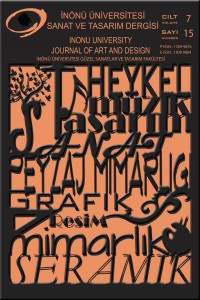Çukurova, Mustafa Kemal ve Toros Üniversiteleri Tasarım Öğrencilerinin Manzara Algılarına Yönelik Bir Araştırma
Öz
Bu çalışmada, gelecekte toplumun fiziksel ve sosyal yaşam ortamını oluşturma eylemine aday olan ve birlikte çalışmaları önem kazanan tasarım öğrencilerinin manzara algıları ve yükledikleri anlamların belirlenmesi amaçlanmıştır. Çalışma-nın birinci aşamasında, standart anket formu aracılığıyla Çukurova bölgesindeki üç üniversitenin Peyzaj Mimarlığı ve Mimarlık bölümleri öğrencilerinin manzara algıları ve yükledikleri anlamlar ortaya konulmuştur. Algı ve anlamlar kapsamın-da; olumlu ve olumsuz manzara kompozisyonu ve bileşenlerinin belirlenmesi hedeflenmiştir. İkinci aşamada, öğrencilerin verdikleri yanıtlar yorumlanarak, olumlu manzarayı oluşturan kavramların kompozisyo-nunda hangi tasarım öge ve ilkelerinin ağırlık kazandığı ve hangi tasarım üslubunun yeğlendiğinin belirlen-mesine çalışılmıştır. Olumsuz manzara oluşturan kavramlar ise verilen yanıtlar-daki kullanım sıklıkları temel alınarak değerlendirilmiştir. Çalışmada ulaşılan ana bulgular; a) Olumlu manzara kompozisyonunda bitkisel tasarım ilkelerine uyularak düzenlenmiş ağaç ve çalı kitleleri ile görsel ve işlevsel nitelikli geniş su yüzeylerinin öne çıktığını, b) Yapısal kompozisyon kapsamında mekânı oluşturan elemanların doğal malzemeler kullanılarak tasarlanmasının mekânın görsel ve işlevsel niteliğini artırdığını ve yapay kent dokusunun ortaya çıkardığı olumsuz etkileri azalttığını, c) Manzaranın geniş ve ferah kullanım alan ve mekânlarından, geniş çim alanlardan, iç içe geçmemiş kullanımlardan oluşması ve bu alan ve mekânların görsel derinlik ve çeşitlilik kazanması durumunda daha fazla olumlu-luk kazandığını, d) Geometrik tasarım üslubunun benimsenmediğini, doğaya öykünen tasarım üslubunun bitkisel tasarımda, karma tasarım üslubunun yapısal tasarımda daha yoğun yeğlendiğini, e) Betonarme yapıların, yapay malzemelerin, tasarımda karmaşa ve bakım yetersizliğinin manzarayı olumsuzlaştıran önemli elemanlar olarak ağırlık kazandığını ortaya koymaktadır.
The aim of the study is to determine the landscape perceptions of design students who are candidates for creating future physical and social life environment and who are important to work together. The study consists of two stages. In the first stage, the Landscape Architecture and Architecture students of three universities in Çukurova region examined perceptions of landscape and their meaning through the standard questionnaire. It was aimed to determine positive and negative landscape composition and its components under the perception and meanings. In the second stage, which design elements and principles gained weight and which design styles preferred in the composition of the concepts forming the positive landscape were determined by interpreting the responses of the students. While the concepts forming the negative landscapes were evaluated on the basis of the frequency of use in the responses given. The main findings of the study were revealed that; a) in favorable landscape composition, trees and shrubs are arranged according to highlighted plantation principles and visual and functional large water surfaces, b) the designing elements of spaces using natural materials enhances the visual and functional quality of the space and reduces the negative effects of urbanization, c) the formation of the landscape and the use of a large grass area give more positive effect to landscape as well as the visual depth and diversity, d) Geometric design style is not adopted by students, the natural design style is more intensively used in plant design, and the mixed design style is more intense in structural design, e) reinforced concrete structures, artificial materials, complexity in design, and lack of maintenance have gained weight as important elements that negate the landscape.
Anahtar Kelimeler
Manzara Görsel Algı Görsel Peyzaj Peyzaj Tasarımı Tasarım Öğrencileri Landscape Visual Perception Visual Landscape Landscape Design Design students
Kaynakça
- Altunkasa, C. (2015). Tasarım Öğrencilerinin Manzara Algıları Üzerinde Bir Araştırma. Ç.Ü. Peyzaj Mimarlığı Lisans Programı Lisans Tezi (Danışman Doç Dr. Cengiz USLU), Adana.
- Bernasconi, C., Strager, M.P., Maskey, V., & Hasanmyer, M. (2009). Assessing public preferences for design and environmental attributes of an urban automated transportation system. Landscape and Urban Planning, 90, 155–167.
- Clay, G.R., & Daniel, T.C. (2000). Scenic Landscape Assessment: the effects of land management jurisdiction on public perception of scenic beauty. Landscape and Urban Planning, 49, 1-13.
- Çakcı, I. & Çelem, H. (2009). Kent Parklarında Görsel Peyzaj Algısının Değerlendirilmesi. Ankara Üniversitesi, Ziraat Fakültesi, Tarım Bilimleri Dergisi, 15(1) 88-95.
- Francescato, D., & Mebane, W. (2005). How Citizens View Two Great Cities: Milan and Rome, in Image & Environment: Cognitive Mapping and Spatial Behavior. Eds: Roger M. Downs, David Stea, Transaction Publishers.
- Kancıoğlu, M. (2005). Çevresel İmaj, Kimlik ve Anlam Kapsamında Turizm Binalarına İlişkin Kullanıcı Değerlendirmeleri. Uludağ Üniversitesi Mühendislik-Mimarlık Fakültesi Dergisi, 10(2), 49-62. Kaplan, R., Kaplan S., & Ryan R.L. (1998). With People in Mind. Island Press, 239.
- Önem, B. & Kılınçaslan, İ. (2005). Haliç Bölgesinde Çevre Algılama ve Kentsel Kimlik”, İTÜ Dergisi/a, Mimarlık, Planlama ve Tasarım, 4(1), İstanbul, 115-125.
- Özak, N.Ö. & Gökmen, G.P. (2009). Bellek ve Mekan İlişkisi Üzerine Bir Model Önerisi. İTÜ Dergisi/a, Mimarlık, Planlama ve Tasarım, 2(8), İstanbul, 145-155.
- Parsons, R. & Daniel, T.C. (2002). Good looking: in defense of scenic landscape aesthetics. Landscape and Urban Planning, 60, 43-56.
- Santos-Delgado, R. (2005). Architectural Landmarks in Davao Cıty: Value-Based Approach to the History of Architecture. Banwa 2(1): 38-62.
- Türkoğlu, H. (2002). Kentsel İmge: İstanbul’dan Bulgular. İTÜ Dergisi/a, Mimarlık, Planlama ve Tasarım, 1(1), İstanbul, 57-64.
- http://www.tdk.gov.tr/index.php?option=com_gts&kelime=manzara
- http://tr.wikipedia.org/wiki/Peyzaj
Ayrıntılar
| Bölüm | Peyzaj Planlama ve Tasarım / Landscape Planning and Design |
|---|---|
| Yazarlar | |
| Yayımlanma Tarihi | 30 Haziran 2017 |
| Gönderilme Tarihi | 4 Temmuz 2017 |
| Kabul Tarihi | 29 Mart 2017 |
| Yayımlandığı Sayı | Yıl 2017 Cilt: 7 Sayı: 15 |


